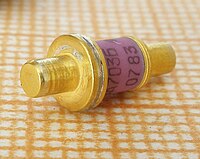
Photo from wikipedia
Abstract Electrical properties of carbonised organic xerogel based on resorcinol–formaldehyde (RF), prepared by pyrolysis at 675 °C in nitrogen atmosphere for two hours, were investigated. In this temperature an insulator to… Click to show full abstract
Abstract Electrical properties of carbonised organic xerogel based on resorcinol–formaldehyde (RF), prepared by pyrolysis at 675 °C in nitrogen atmosphere for two hours, were investigated. In this temperature an insulator to semiconductor-like transition occurs. The voltage–current (V–I) characteristics indicate the presence of non-linear conductivity depending on the measurement temperature. The origin of the non-linearity in the electrical conductivity is discussed using different theoretical models. The obtained results reveal that this non-linear conductivity starts above a threshold current, which is illustrated by the presence of negative differential resistance (NDR) region. The properties of the obtained NDR are controlled by the applied current and are attributed to a percolation phenomenon in the carbonised sample. The obtained result is very promising for many applications in power electronic technology specially for the development of some negatronic devices.
Journal Title: Chemical Physics
Year Published: 2019
Link to full text (if available)
Share on Social Media: Sign Up to like & get
recommendations!